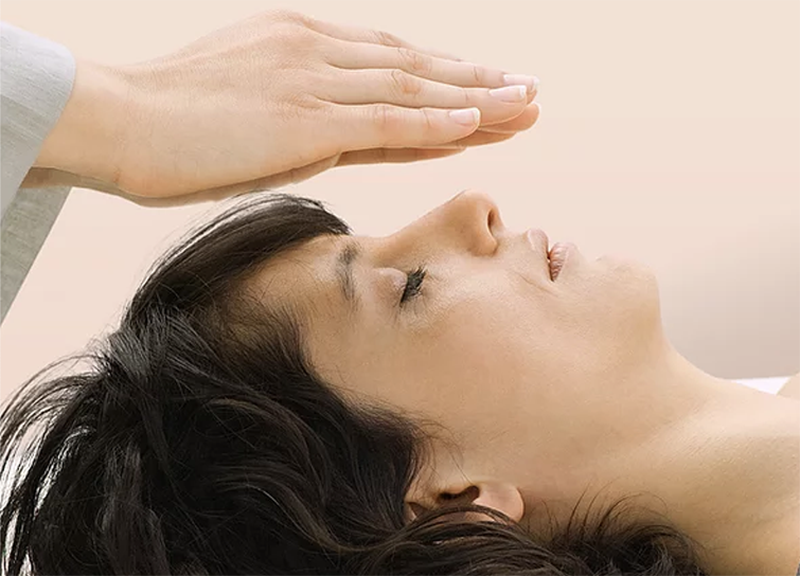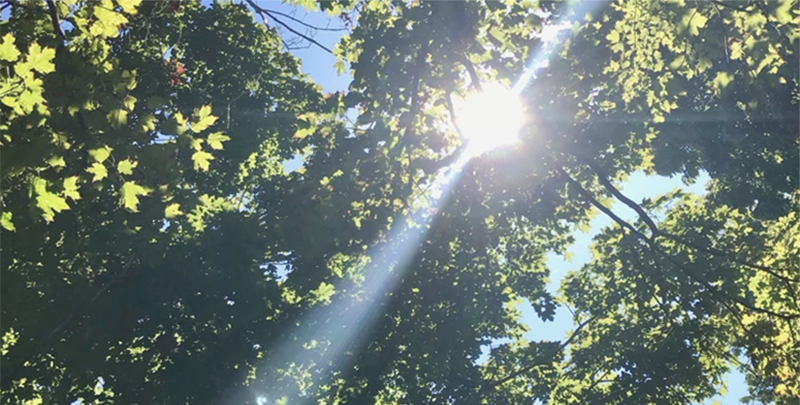If one good thing has come out this ongoing pandemic, it’s that mental health and chronic pain have come out of the shadows and into the public discourse. And while treatment remains fraught with inequity, lack of access, and highly addictive medications, we are witnessing the beginnings of a paradigm shift towards a more holistic approach. Here in Champaign-Urbana, you may have noticed that along with acupuncture, counseling, meditation, massage therapy, the availability of Reiki energy healing is on the rise. But unlike these other modalities, Reiki is particularly challenging to introduce. Invisible to the naked eye, Reiki requires a bit of faith (with a small f, please) and the willingness to expand one’s understanding of the mind-body connection.
As someone who has lived on both sides of the Reiki table (client/practitioner), I have often described it a massage for energy body, rather than your physical body, or a tune up for blocked energy. Folks with experience in yoga and meditation, and therefore a good working understanding of energy pathways are often drawn to Reiki as both practitioners and clients; as a those working with other holistic, non-Western modalities such as Reflexology. They see it as another tool in the toolbox, one that can be learned and even practiced on one’s self. However, when I learned that Reiki was being offered at Pure Being as a companion to psychotherapy, I felt hopeful that Reiki had finally shed its negative New Agey stereotype. That this powerful form of healing, often referred to as “the laying of hands,” was finally getting its due.
To further explore the state of Reiki in C-U, I reached out to three local practitioners. Each brings a different perspective and an approach to their practice. We talked about how to describe Reiki, how it works, and its immediate and long-term benefits. I hope their stories inspire you to consider experiencing Reiki energy healing for yourself.

Photo from the Pure Being website.
Marlita, of Nature’s Wonder in Woodland, Illinois, was my first Reiki teacher. She is a living example of Reiki’s ability to bring balance. As a teacher, she was accessible, honest, funny, and surprisingly practical. This interview gave me the opportunity to reconnect with her. When asked how she described Reiki, she called it “a mysterious, intelligent energy often referred to as life force energy, present in all living beings. For me it is hard to explain. I only know that it does make a difference for the receiver.” She went to share that “to those who have not received it, I encourage the individual to have a session to experience it for themselves. It is different for everyone and I feel it is best not to influence the receiver in any way. The most common description is gentle and relaxing. Some feel lighter afterward, some feel relaxed, some feel energized, some have emotional releases. It is an individual healing depending on what is going on with the receiver.” Hasbargen is a Reiki Master, which means that after completing level one and two and is now able to train other practitioners to become Masters themselves.
Hasbargen notes that “Reiki energy seems to have an intelligence of its own. It goes where it is needed. It also works with the free will of the receiver. The receiver is always in control; it can be received or rejected, as Reiki energy never goes against the free will of the receiver. She’s found that t”he biggest misconception is that the Reiki Practitioner must touch the receiver. Reiki Energy can be “beamed” across a room or around the globe. It works the same way as saying a prayer. Usually, you are not touching the person you are praying for, but they still receive the energy.”
Having trained several massage therapists to become Reiki practitioners, Hasbrgen firmly believes that “Reiki can work well with most other modalities.” Her advice for those wishing to explore Reiki is “find a practitioner that you resonate with and have a session. That’s the only way you will truly know what it can do for you. Go into it with an open mind without any preconceived ideas of what will happen.” For those considering Reiki training, Hasbargen suggests “Find a Reiki Master/Teacher that you are comfortable with. Have a session or two with them to see how you feel. Use your intuition.” Now more than ever, she feels that “people are looking for more ways to help themselves and others.” She continues to practice Reiki in person with full masking and other COVID precautions in place.
Jessica Nolen is a licensed massage therapist, certified yoga instructor, and a Reiki Master. For her, these modalities are inherently compatible and stronger together. Having studied Reiki with Nolen, as well as benefited from her massage therapy, I can testify to her deep knowledge and experience with how life force energy works and how to go about treating it when it is blocked. In my conversation with Nolen she began with a quote from Nikola Tesla. “My brain is only a receiver. In the Universe, there is a core from which we obtain knowledge, strength, and inspiration. I have not penetrated into the secrets of this core, but I know that it exists.” These words set the framework for our discussion. Nolen went on to note that “In all forms of energy medicine, it is this core that we are ultimately attempting to form an awareness of, such that we may be able to optimize our health and general well-being as energetic beings having a human experience. Reiki is defined as Universal Life Force Energy. This energy flows naturally and freely when we are in a healthy state. It becomes blocked when we are suffering from mental, emotional and physical traumas.”
When it comes to treating these blocks, Nolen notes that “Western medicine lost its way when it began separating these three aspects of human experience from each other, to the point where we now have specialists for every part of the body, and gave little to no attention to mental and emotional health or the actual roots of the health problems we experience. The opioid crisis and expanding list of mental ‘disorders’ in the DSM-5 are symptoms of this separation.”
Nolen draws an important distinction between Western and non-Western approaches to healing: the role of the patient. Non-Western approaches “require the utilization of what we might call our 6th sense or intuition, and learning how to interpret this information, as well as developing some relative discernment about what is perceived, and what we think about what we are perceiving. It requires a development of emotional literacy, such that we can maintain emotional equanimity as much as possible, and become relatively objective observers. It requires meditation, time, and a level of self-trust that can be difficult to obtain and maintain in the face of doubt and and skepticism, especially that which is coming from a materialist view of reality. When we step into the realm of the unknown, we must have at least a little faith to motivate us to keep trying, and to loosen our grip on what we think we know.” Nolen lists formal counseling, group therapy and support groups, self study and journaling, yoga, meditation as practices which “help us to gain a deeper understanding about our mental/emotional resistances.”
Diving deeper into a Non-Western understanding of ourselves and out relationship to the world, Nolen reminds us that energy blocks, along with the stress and pain that result, have societal impacts. Leaning into what Marianne Williamson calls “our attitudinal muscles,” we are able to see that “we are inherently connected and perhaps not separate from each other and all things at all.” Therefore, she notes “when we see the world in this way, we gain a deeper sense of the need for balance in all things. In the physical body, we develop problems when our regulatory systems are out of balance, just as in the societal body, we develop problems when our governing regulatory systems are out of balance. We cannot separate the individual in a single body from the rest of society.”
Informed and inspired by the work of Brene Brown, Doug Nelson, founder of Bodywords and author of The Mystery of Pain, and Marshall B. Rosenberg’s Non-Violent Communication,” Nolen underscores the need to reframe how we relate to each ourselves and each other. In post-COVID life, we must learn this.
Every problem or catastrophe calls us to either react or to respond. When we react, we are making decisions and taking action from a place of fear, informed by our default programming and past experiences. When we respond, we take the time to turn to our practices to regain emotional equanimity, while analyzing our experiences as objectively as possible, even if that practice is just closing our eyes and taking 10 deep breaths. We respond from a place of Love and deep compassion. Life is not an emergency.
This kind of transformation takes courage. And to acknowledge it, Nolen ends each session by thanking them, “not only for their trust, but most importantly, for their courage.”
Sarah Reynertson operates from a combined therapeutic model. As a Licensed Clinical Professional Counselor (LCPC), a Certified Grief Counseling Specialist (CGCS), and Level 2 Reiki Practitioner, her practice offers the best of both worlds. When we met via Zoom, Reynertson explained that Reiki is something she often introduces after working with a client for a while. She waits for trust to be established and to see if Reiki might be a good fit. Counseling often excavates long-held trauma and working through it can be painful and challenging. She can use Reiki to help a client unblock a trauma and address some of the pain manifesting from it. And while all Reiki practitioners can treat trauma, the question is whether or not all should. As we spoke, I found myself believing that, particularly in the case of acute and newly opened traumas, this work may be best left in the hands of a licensed professional.
When I asked Reynertson what advice she might give to those looking to practice Reiki energy healing, she drew upon her experience training to become an LCPC. As a part of their training, counselors are required to undergo counseling themselves. Not just to experience the process first hand, but, more importantly, to identify and address their own mental health concerns (and yes, we all have those, even counselors). This awareness of one’s own well-being is key to counselors and Reiki practitioners alike. Reynertson shared that there are times when she knows she can’t offer her best self to a client and will consider postponing until she can. Doing so is not only in her best interest, but in the best interest of the client. Practitioners, like clients, Reynertson observed, are best served when they have access to a variety of therapeutic modalities and trusted practitioners.
I ended our conversation an awareness that balance, as the Yogis know, is maintained not achieved. And so it goes for our energetic balance and the health of our mind-body connection. Whether we are participating in the wellness journeys of others, or simply (or not so simply) our own, the first step is acknowledging that healing of any kind is a contiunous and evolving process; one best entered into actively, rather than passively.
Contact Marlita Hasbargen at Nature’s Wonders via Facebook. Contact Jessica Nolen by email at [email protected]. Learn more about Sarah Reynertson on the Pure Being website.








